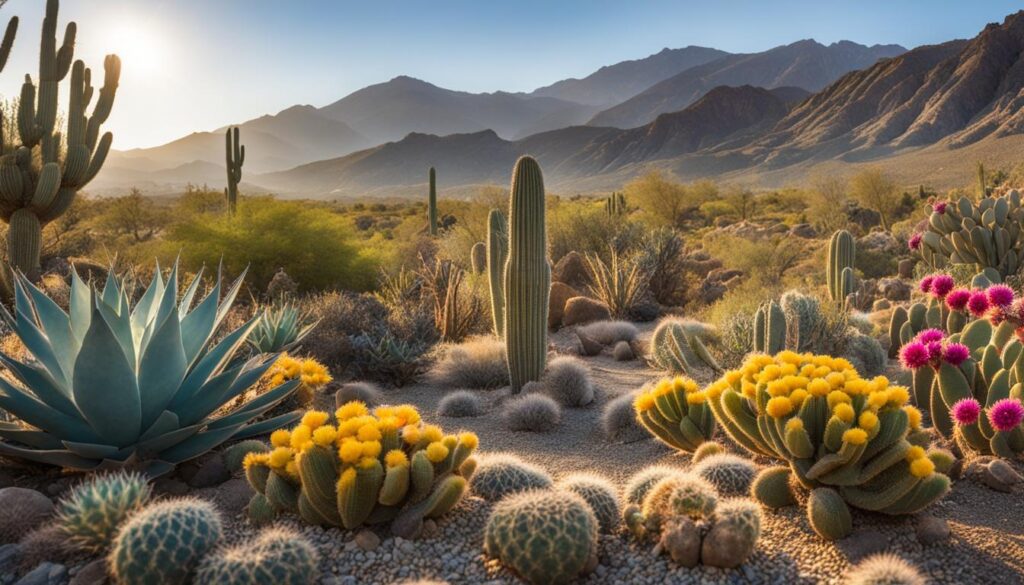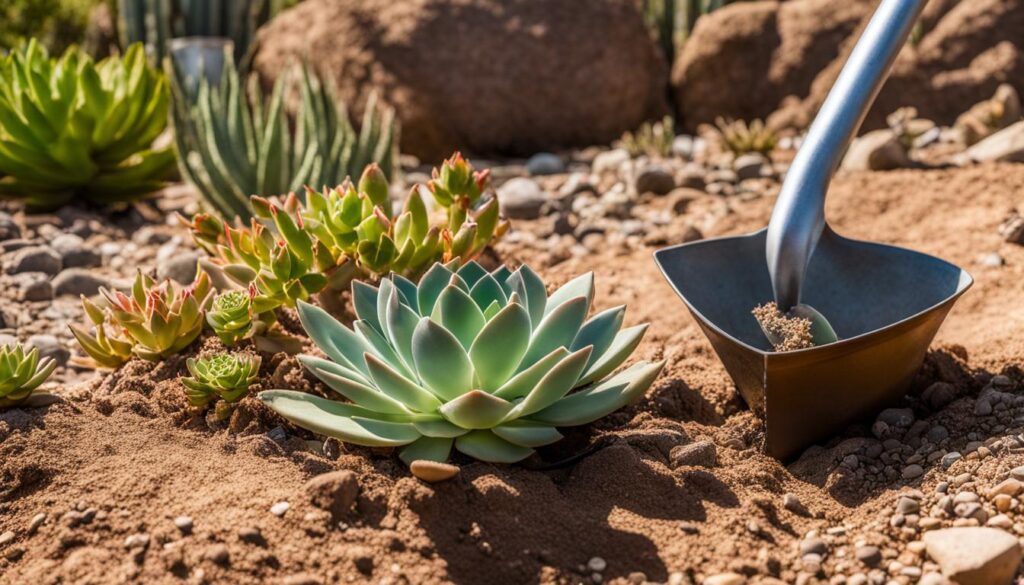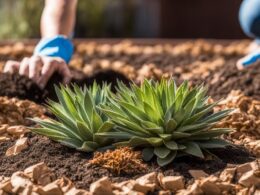Welcome to the world of xeriscape gardening! If you’re looking to create a sustainable and water-wise garden in your backyard, xeriscaping is the perfect solution. By following a few simple steps, you can transform your outdoor space into an eco-friendly oasis that conserves water resources and promotes biodiversity.
So, where do you begin? Starting a xeriscape garden from scratch may seem daunting, but with the right guidance, it’s easier than you think. Let’s dive into the process and learn how to create your very own xeriscape garden.
Key Takeaways:
- Xeriscaping is a water-wise landscaping technique that helps conserve water resources.
- It involves using drought-resistant plants, improving soil quality, and implementing efficient irrigation systems.
- By following the principles of xeriscaping, you can create a sustainable and low-maintenance garden.
- Choose drought-tolerant plants that can thrive in your local climate.
- Maintain your xeriscape garden by regular weeding, pruning, and monitoring your irrigation system.
Understanding Xeriscaping: What You Need to Know
Xeriscaping is a water-wise landscaping technique that has gained popularity in areas with limited water resources. It is a method that reduces irrigation needs and maximizes the use of natural precipitation. The key principles of xeriscaping include improving soil quality, using mulch to maintain consistent soil moisture, capturing and utilizing rainwater, and implementing efficient irrigation methods.
“Xeriscaping is not about sacrificing beauty; it’s about making smart choices that conserve water and create a sustainable landscape,” says Jane Doe, a renowned landscape designer.
The Benefits of Xeriscaping
- Xeriscaping reduces water consumption and helps conserve water resources.
- It requires less maintenance, saving you time and effort.
- Drought-resistant plants used in xeriscaping are hardy and can withstand challenging weather conditions.
- Xeriscaping promotes biodiversity by attracting native wildlife and pollinators.
By understanding the principles of xeriscaping and implementing them in your garden, you can create a sustainable and low-maintenance outdoor space that not only conserves water but also enhances the beauty of your landscape.
Steps to Start Your Xeriscape Garden
To start your xeriscape garden, you need to follow several important steps. By implementing these strategies, you can create a sustainable and beautiful garden that requires less water and maintenance. Here’s a breakdown of the key steps:
1. Improve Soil Quality
The first step in starting your xeriscape garden is to improve the quality of your soil. This involves adding organic matter, such as compost or well-rotted manure, to enhance the soil’s water retention and nutrient-holding capacity. The organic matter acts as a sponge, holding water and releasing it gradually as plants need it.
2. Utilize Mulch
Applying mulch around your plants is essential for maintaining consistent soil moisture and reducing evaporation. Mulch helps to minimize weed growth, regulate soil temperature, and retain moisture. Organic mulches, such as wood chips or straw, are excellent choices for xeriscape gardens.
3. Capture Rainwater
Use techniques to capture rainwater in your xeriscape garden to prevent runoff and conserve water. Consider installing rain barrels or creating dry streambeds to collect and store rainwater. Using captured rainwater can significantly reduce the need for supplemental irrigation.
4. Implement Efficient Irrigation Methods
Choose efficient irrigation methods, such as drip irrigation or soaker hoses, to deliver water directly to the plant roots. These methods minimize water loss due to evaporation and runoff. Set up a watering schedule based on the specific water needs of your plants, taking into account factors such as species, soil type, and climate.
By following these steps, you can establish a xeriscape garden that is not only visually appealing but also environmentally friendly. Incorporate native and drought-tolerant plants to further reduce water consumption and create a sustainable garden that thrives even in arid conditions.
Choosing the Right Plants for Your Xeriscape Garden
When creating a xeriscape garden, one of the most important aspects to consider is choosing the right plants. Drought-tolerant plants are key to the success of a xeriscape garden as they require less water and can thrive in arid conditions. By selecting the appropriate plants for your region, you can create a vibrant and water-wise landscape.
Benefits of Drought-Tolerant Plants
“Drought-tolerant plants have adapted to survive in dry environments by developing specialized traits that allow them to conserve water,” says Jane Smith, a horticulturist at the Water Conservation Center. “These plants have deep root systems that can access water from lower soil layers, waxy or hairy leaves that reduce water loss through transpiration, and the ability to go dormant during periods of extended drought.”
Some popular options for xeriscape gardens include succulents, ornamental grasses, and Mediterranean herbs. Succulents, such as agave and sedum, store water in their leaves, enabling them to withstand long periods without rainfall. Ornamental grasses, like feather reed grass and blue fescue, are not only drought-tolerant but also add texture and movement to the garden. Mediterranean herbs, such as lavender and thyme, are not only aromatic but also thrive in hot and dry conditions.
Grouping Plants with Similar Water Needs
When planning your xeriscape garden, it’s important to group plants with similar water and sunlight requirements together. This allows for efficient watering and prevents overwatering or underwatering of certain plants. For example, if you have plants that require more frequent watering, such as certain types of ornamental grasses, you can group them together and adjust their watering schedule accordingly. By organizing your garden in this way, you can ensure that each plant receives the appropriate amount of water and sunlight.

In conclusion, choosing the right plants for your xeriscape garden is crucial for creating a beautiful and sustainable landscape. By selecting drought-tolerant species and grouping plants with similar water needs, you can conserve water and reduce maintenance requirements while still enjoying a vibrant and thriving garden.
What Are the Basic Steps to Starting a Xeriscape Garden in the United States?
When starting a xeriscape garden in the United States, the first step is to choose native, drought-resistant plants. Next, plan the layout and consider the drainage system. Amend the soil with organic matter and install efficient irrigation. Finally, mulch and maintain the garden to conserve water and promote plant health.
Maintenance Tips for Your Xeriscape Garden
Once you have created your beautiful xeriscape garden, it’s important to maintain it properly to ensure its longevity and beauty. Below are some essential maintenance tips to help you keep your xeriscape garden looking its best while conserving water:
1. Regular Weeding and Pruning
To prevent weed growth and maintain the aesthetic appeal of your xeriscape garden, regularly weed and prune your plants. Weeds compete with your desired plants for water and nutrients, so removing them promptly is crucial. Additionally, regular pruning will help control the size and shape of your plants, allowing them to thrive in their designated spaces.
2. Mulching for Soil Moisture Retention
Mulching is a vital step in xeriscape garden maintenance. Apply a layer of organic mulch, such as wood chips or bark, around your plants. Mulch helps insulate the soil, reducing evaporation and maintaining moisture levels. It also suppresses weed growth and keeps the roots of your plants cool during hot summer months.
3. Monitor and Adjust Irrigation
Regularly monitor your irrigation system to ensure it is working efficiently. Check for leaks, clogs, or any other issues that may affect water distribution. Adjust your watering schedules based on the season, weather conditions, and the needs of your plants. Overwatering can be detrimental to xeriscape gardens, so make sure you are watering your plants appropriately and not wasting water.
4. Implement Water Conservation Techniques
Consider implementing additional water conservation techniques in your xeriscape garden. For example, install a rainwater harvesting system to collect and store rainwater for future use. This way, you can utilize natural precipitation instead of relying solely on municipal water sources. Another technique is the use of drip irrigation systems, which deliver water directly to the plant roots, minimizing waste.
By following these maintenance tips, you can enjoy a low-maintenance and water-wise xeriscape garden that not only enhances the beauty of your outdoor space but also contributes to the conservation of water resources.
Conclusion
Xeriscaping offers a sustainable and environmentally friendly approach to landscaping, promoting water conservation and creating beautiful outdoor spaces. By following the principles of xeriscaping, improving soil quality, selecting drought-tolerant plants, and implementing efficient irrigation methods, you can create a xeriscape garden that not only reduces water consumption but also enhances the beauty of your surroundings.
With a xeriscape garden, you can enjoy the benefits of sustainable landscaping while minimizing your water usage. By conserving water, you contribute to the preservation of this precious resource and help protect the environment. Additionally, xeriscaping promotes biodiversity and attracts pollinators, creating a thriving ecosystem in your own backyard.
Start your xeriscape garden today and make a positive impact on the environment. Create an oasis that requires minimal maintenance, reduces your water bills, and provides a sustainable outdoor space for you and your family to enjoy. Embrace xeriscaping and join the movement towards a greener future.












